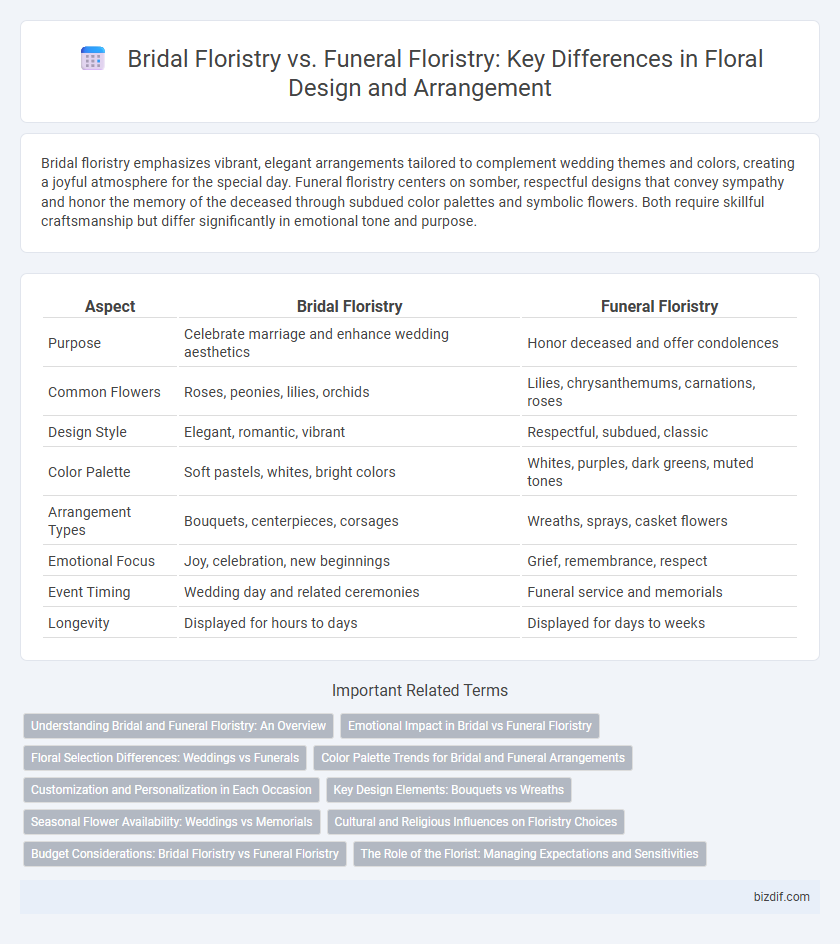Bridal floristry emphasizes vibrant, elegant arrangements tailored to complement wedding themes and colors, creating a joyful atmosphere for the special day. Funeral floristry centers on somber, respectful designs that convey sympathy and honor the memory of the deceased through subdued color palettes and symbolic flowers. Both require skillful craftsmanship but differ significantly in emotional tone and purpose.
Table of Comparison
| Aspect | Bridal Floristry | Funeral Floristry |
|---|---|---|
| Purpose | Celebrate marriage and enhance wedding aesthetics | Honor deceased and offer condolences |
| Common Flowers | Roses, peonies, lilies, orchids | Lilies, chrysanthemums, carnations, roses |
| Design Style | Elegant, romantic, vibrant | Respectful, subdued, classic |
| Color Palette | Soft pastels, whites, bright colors | Whites, purples, dark greens, muted tones |
| Arrangement Types | Bouquets, centerpieces, corsages | Wreaths, sprays, casket flowers |
| Emotional Focus | Joy, celebration, new beginnings | Grief, remembrance, respect |
| Event Timing | Wedding day and related ceremonies | Funeral service and memorials |
| Longevity | Displayed for hours to days | Displayed for days to weeks |
Understanding Bridal and Funeral Floristry: An Overview
Bridal floristry emphasizes vibrant, delicate arrangements tailored to complement wedding themes and symbolize love and celebration, often featuring roses, peonies, and lilies. Funeral floristry prioritizes somber, respectful designs that convey condolences, incorporating flowers like chrysanthemums, lilies, and carnations known for their association with mourning and remembrance. Both styles require specialized knowledge of floral symbolism, durability, and arrangement techniques to suit the distinct emotional contexts and settings.
Emotional Impact in Bridal vs Funeral Floristry
Bridal floristry emphasizes vibrant, joyful arrangements that symbolize love, hope, and new beginnings, often featuring roses, peonies, and lilies to evoke happiness and celebration. Funeral floristry, in contrast, uses subdued colors and serene flowers such as chrysanthemums, lilies, and carnations to convey sympathy, remembrance, and respect, offering comfort to grieving families. The emotional impact in bridal floristry centers on uplifting moods and creating lasting positive memories, while funeral floristry aims to provide solace and honor the departed with dignity.
Floral Selection Differences: Weddings vs Funerals
Bridal floristry emphasizes vibrant, fragrant flowers such as roses, peonies, and lilies to symbolize love, joy, and new beginnings, often using pastel and white color palettes to complement wedding themes. Funeral floristry prioritizes subdued, solemn arrangements featuring chrysanthemums, carnations, and lilies in muted tones like white, purple, and blue to convey sympathy, respect, and remembrance. The floral selection differences reflect contrasting emotional atmospheres, with weddings celebrating life and funerals honoring loss.
Color Palette Trends for Bridal and Funeral Arrangements
Bridal floristry embraces soft, romantic color palettes such as blush pinks, ivory whites, and pastel lavender, reflecting themes of love and celebration. Funeral floristry traditionally favors somber tones like deep purples, muted greens, and white lilies, symbolizing respect, remembrance, and peace. Both color trends align with the emotional tone of the event, influencing flower choices and arrangement styles in professional floristry.
Customization and Personalization in Each Occasion
Bridal floristry emphasizes customization through vibrant, seasonal blooms that reflect the couple's theme, colors, and personal love story, creating unique arrangements like bespoke bouquets and decorative centerpieces. Funeral floristry prioritizes personalization by selecting specific flowers and designs that symbolize remembrance and respect, often incorporating meaningful elements such as the deceased's favorite flowers or colors. Both occasions demand tailored floral artistry, but bridal floristry focuses on celebration and joy, while funeral floristry centers on honoring legacy and evoking solemnity.
Key Design Elements: Bouquets vs Wreaths
Bridal floristry emphasizes elegant, personalized bouquets designed with soft colors, delicate flowers like roses and peonies, and symbolic greenery to complement wedding themes and attire. Funeral floristry focuses on wreaths featuring somber tones, traditional blooms such as lilies and chrysanthemums, and structured arrangements that offer respect and remembrance. The key design elements differ in shape, symbolism, and emotional expression tailored to joyous celebrations or solemn farewells.
Seasonal Flower Availability: Weddings vs Memorials
Seasonal flower availability significantly impacts bridal floristry, where fresh blooms like peonies, roses, and lilies are selected based on the wedding date to enhance aesthetic appeal and theme. Funeral floristry prioritizes flowers with extended vase life, such as chrysanthemums, carnations, and lilies, ensuring durability throughout memorial services regardless of season. Florists often adjust designs and flower choices to accommodate the variable availability and symbolic meanings associated with each occasion.
Cultural and Religious Influences on Floristry Choices
Bridal floristry often incorporates vibrant, symbolically rich flowers that align with cultural traditions, such as roses for love in Western weddings and marigolds for prosperity in Indian ceremonies. Funeral floristry, conversely, features subdued, reflective arrangements like lilies and chrysanthemums, which hold solemn significance in many religions including Christianity and Buddhism. These choices are deeply influenced by cultural customs and religious beliefs, guiding the selection and presentation of floral designs in both life celebrations and mourning rituals.
Budget Considerations: Bridal Floristry vs Funeral Floristry
Bridal floristry typically involves a higher budget allocation due to the demand for elaborate arrangements, diverse flower varieties, and custom designs that complement wedding themes. Funeral floristry generally requires a more modest budget, focusing on respectful, somber designs often using seasonal or locally-sourced flowers to manage costs. Budget considerations must account for event scale, floral complexity, and emotional significance in both scenarios.
The Role of the Florist: Managing Expectations and Sensitivities
Bridal florists tailor arrangements to celebrate joy and beauty, ensuring each bouquet reflects the bride's vision and complements the wedding theme, while maintaining open communication to manage expectations sensitively. Funeral florists handle delicate emotional situations, creating respectful and meaningful tributes that honor the deceased, often coordinating closely with families to address cultural or religious customs. Both require empathy, precise attention to detail, and a professional approach to meet diverse client needs while navigating important emotional contexts.
Bridal floristry vs funeral floristry Infographic

 bizdif.com
bizdif.com